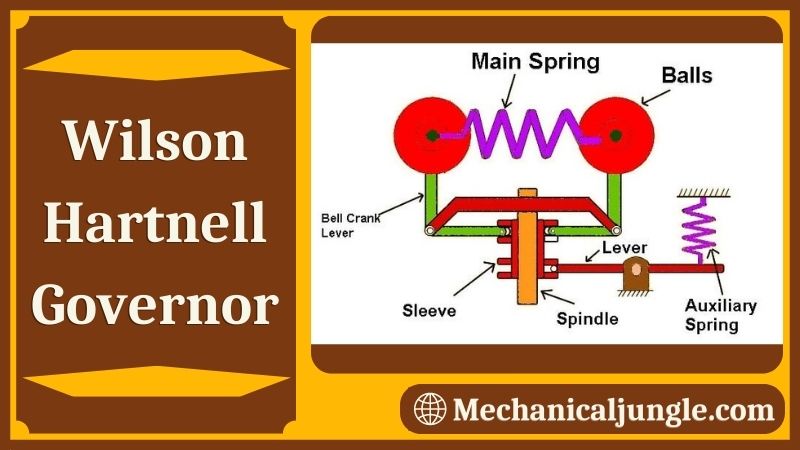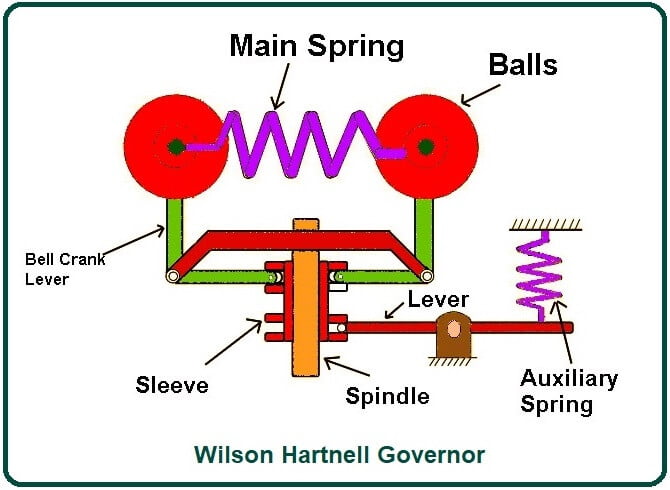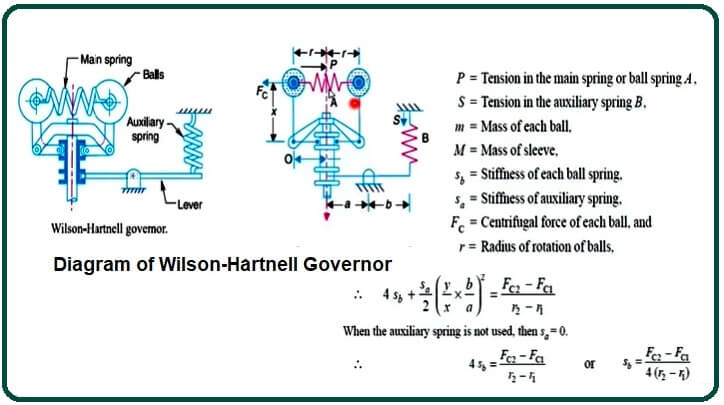
What Is Wilson-Hartnell Governor?
The Wilson-Hartnell governor is a spring-controlled load governor classified under centrifugal governors.
We have discussed Hartung governor and Hartnell governor in previous articles, which are also spring-loaded governors with different constructions and working principles of this type of governor.
Wilson Hartnell Governor:

It is also known as a spring-loaded governor. It is a special type of governor in which a spring is attached between the balls of the governor. This spring is called Main Spring.
The mainspring is stretched and placed between the balls, which means that the mainspring always exerts an inward force to both fly balls. It also has another spring which is known as an auxiliary spring. It is connected to the auxiliary spring sleeve via a pivoted lever.
Construction of Wilson Hartnell Governor:
In Wilson Hartnell Governor, fly balls are connected to each other through spring. This spring is called the main wire and is placed between the balls in a stretched position and forces both balls inward. Apart from this spring, thises governor also has an assistant spring.
These auxiliary springs are connected to the sleeve through a lever. When the sleeve moves up, the other part of the lever moves down, and the supporting spring is pulled, and the other part of the lever is pulled upward, and the sleeve is upward. This auxiliary spring helps maintain the balance speed of the governor.
These two balls are attached to the rollers through the bell crank lever. This bell crank lever is also known as a ring. The rollers are attached to the sleeves. Two fly balls and spindles are attached to the engine shaft that rotates the spindle.
Working of Wilson Hartnell Governor:
When the spindle rotates, the bell cranks lever rotates with the spindle, and the fly ball attached to the crank lever rotates as well; the centrifugal force is experienced by the two balls that pull the ball away from each other but in the mainspring balls.
Pulls one towards the other. When the rotation speed of the spindle increases, the radius of rotation of the balls increases. Due to the external movement of the balls, the bell crank lever lifts up and so lifts the sleeve. So when the sleeves go up, the fuel supply decreases.
When the rotation speed of the spindle decreases, the radius of rotation of the balls decreases, and the balls get closer to each other. Due to the arrival of the balls, the bell crank lever moves down, and hence the sleeve goes down. The fuel supply increases when the sleeve goes down.
The bell crank lever rotates along the spindle. When the speed increases the rotation radius of the ball increases. The ball’s outward motion activates the bell crank lever and lifts the governor sleeve—the upward movement of the sleeve in the fuel supply decreases, and therefore, the engine speed decreases.
Likewise, when the spindle speed decreases, the ball moves inward. This is the result of the fall of the governor sleeve and the increase in fuel supply.
Diagram of Wilson-Hartnell Governor:

FAQs (Frequently Asked Questions) that you could include in your article about the Wilson-Hartnell Governor:
What is a Wilson-Hartnell Governor?
The Wilson-Hartnell Governor is a type of spring-loaded, centrifugal governor used in engines to regulate speed by controlling the fuel supply.
How does the Wilson-Hartnell Governor work?
It works on the principle of centrifugal force. As the engine speed increases, the governor’s fly balls move outward, lifting a sleeve that reduces fuel supply. Conversely, as speed decreases, the balls move inward, increasing fuel supply.
What are the main components of the Wilson-Hartnell Governor?
The main components include fly balls, a main spring that pulls the balls inward, an auxiliary spring connected to a lever for fine adjustments, a bell crank lever, and a sleeve that controls the fuel supply.
What is the role of the main spring in the Wilson-Hartnell Governor?
The main spring exerts a constant inward force on the fly balls, opposing the centrifugal force generated as engine speed increases.
How does the auxiliary spring contribute to the governor’s function?
The auxiliary spring allows for fine adjustments in the governor’s response by varying the tension on the sleeve through a lever mechanism.
What advantages does the Wilson-Hartnell Governor offer over other types of governors?
It provides stable speed regulation across varying engine loads and is relatively simple in construction, making it reliable and easy to maintain.
Where is the Wilson-Hartnell Governor typically used?
It is commonly found in small to medium-sized engines where precise speed control is necessary, such as in generators, pumps, and certain types of machinery.
How does the Wilson-Hartnell Governor compare to other types of centrifugal governors?
Compared to other governors like the Hartung or Hartnell governors, the Wilson-Hartnell design emphasizes simplicity and robustness while maintaining effective speed control capabilities.
What maintenance is required for a Wilson-Hartnell Governor?
Regular inspection of springs, fly balls, and lubrication points is necessary to ensure proper functioning. Adjustments may be needed over time to maintain optimal performance.
Can the Wilson-Hartnell Governor be adapted for use in modern engine systems?
Yes, adaptations and refinements have been made to integrate Wilson-Hartnell principles into modern engine control systems, ensuring its relevance in contemporary applications.

